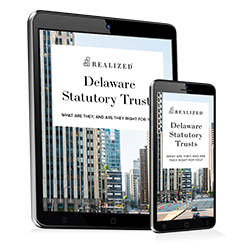
Some investors struggle with the differences between DSTs (Delaware Statutory Trusts) and TICs (Tenant-In-Common). Both allow you to invest fractionally in real estate. Both can be used with a 1031 exchange.
In this article, we’ll dive into the details of TICs and DSTs to help you make a more informed decision about each investment vehicle, and ultimately determine which is better for your investing strategy and unique situation.
Hands-Off
If you want exposure to real estate investments but don’t want to get involved in the day-to-day activities of managing an investment property, then a DST will fill that need. DSTs are truly passive investments. Management of the property is left to the property manager and sponsor.
That isn’t the case with TICs. TIC co-owners are more involved in property management. At the least, they must vote on various management issues about the property, which the sponsor will then carry out. While that may sound fairly passive, keep in mind that TICs require the unanimous consent of co-owners on any major decisions — a task that can sometimes be difficult to accomplish because of disagreements.
Fewer Investor Limitations
There is no IRS imposed limitation on the number of investors that can be in a DST. TICs restrict the number of investors to 35. If financing is involved, TIC lenders may further limit the number of investors, sometimes down into the single digits.
DST Vs. TIC Financing
Any debt taken on by a DST doesn’t show up as investor debt. Instead, the debt is held under the DST since it holds title to the property, and the DST is the single borrower. The DST investor doesn’t carry a mortgage on their balance sheet and any debt allocated to them is non-recourse.
For TIC co-owners, they do carry a mortgage since each TIC owner holds title to the property. Depending on the property and number of co-owners, it can be more difficult to get financing for a TIC. For example, a TIC with 35 co-owners presents a lot of administrative complexity for lenders, which some will simply pass on.
Because of limitations on the number of TIC co-owners, when purchasing a large property, each co-owner must increase the amount they are purchasing. In contrast, a DST can attract more investors to help offset the required amount for each investor.
Minimums
Because DSTs can have far more investors than TICs, minimums are much lower. Many TICs require at least a $500,000 investment. Most DSTs require as little as $100,000 for 1031 exchange investors and even less for cash investments.
With lower minimums, DST investors can diversify their real estate investments. Because of the high minimum that most TICs require, the average investor may have a more difficult time diversifying their holdings, as much of their equity is invested in one structure.
Potential TIC Legal Issues
It’s worth mentioning that TIC co-owners must set up an LLC to shield their personal assets in the event the TIC runs into legal issues or files for bankruptcy. DSTs don’t require any additional entities to protect investor assets because the trust itself already provides those same protections. Most DST financing is non-recourse, which means a default is subject only to the property and not the investors.
Also, investors do not own the property that the DST is invested in. There is no legal blowback to the investors. Investors simply purchase beneficial interests in a trust.
1031 Exchange Options
When executing a 1031 exchange, DSTs and TICs both qualify for like-kind purposes. When either is sold in the future, investors can complete a subsequent 1031 exchange if they choose to do so. However, a 1031 exchange requires “equal or greater debt,” which makes DSTs an option because of their various financing ratios and non-recourse debt structure.
Compared to a TIC, DSTs are designed to offer a more simplified and efficient method for investing in real estate. DSTs invest in larger, institutional-grade properties as well. When it comes to doing a 1031 exchange, DSTs can provide investors with an easier path for tax deferral.
Diversification does not guarantee a profit or protect against a loss in a declining market. It is a method used to help manage investment risk.
No public market currently exists, and one may never exist, for the interests of any DST program. The purchase of interests in any DST program is speculative and is suitable only for persons who have no need for liquidity in their investment and who can afford to lose their entire investment.
This material is for general information and educational purposes only. Information is based on data gathered from what we believe are reliable sources. It is not guaranteed as to accuracy, does not purport to be complete and is not intended to be used as a primary basis for investment decisions. It should also not be construed as advice meeting the particular investment needs of any investor.



